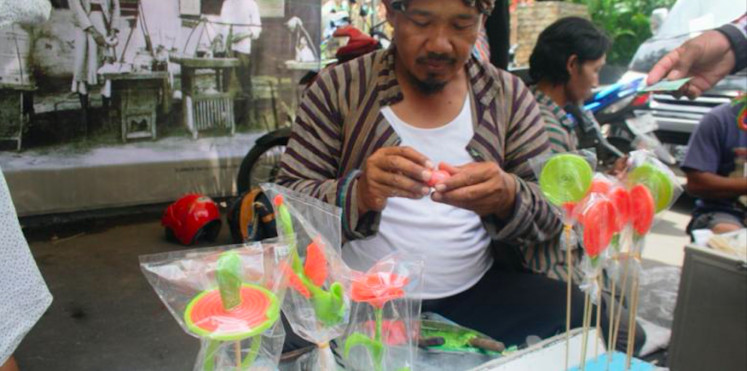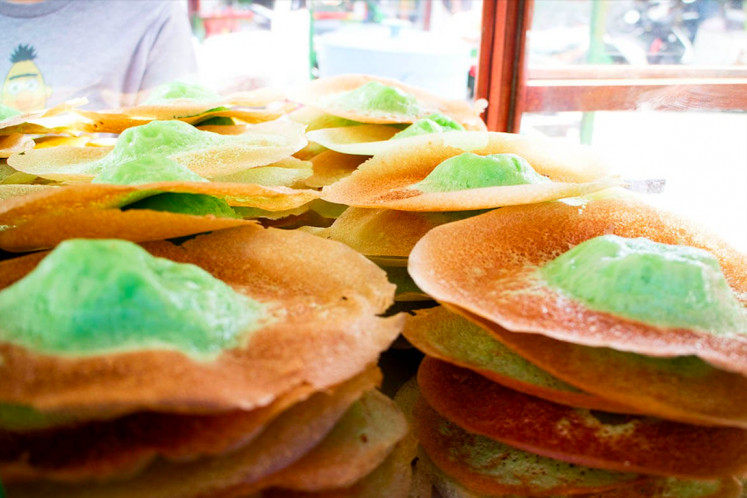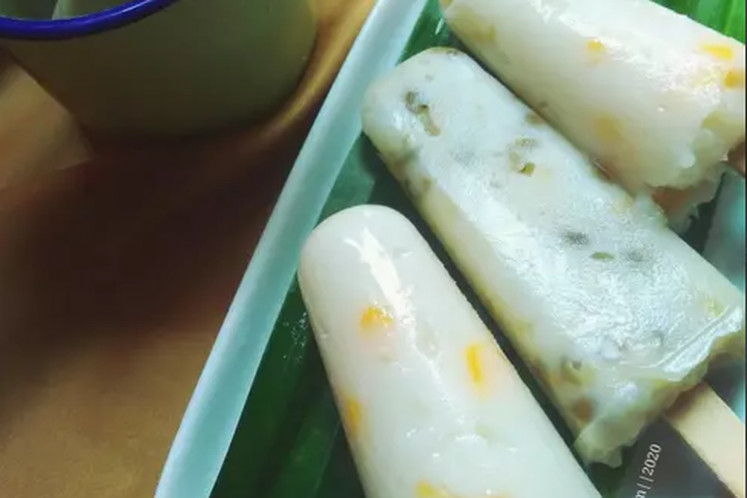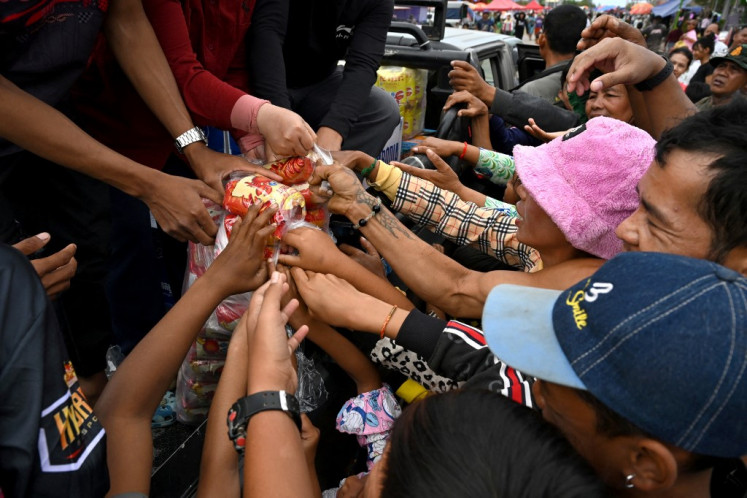Popular Reads
Top Results
Can't find what you're looking for?
View all search resultsPopular Reads
Top Results
Can't find what you're looking for?
View all search resultsTwenties: Nostalgia for the Indonesian childhood snacks we all loved
Change text size
Gift Premium Articles
to Anyone
T
wenties is a new column where The Jakarta Post offers top 20 lists of anything and everything of interest, from food and history to pop culture and lifestyle items.
There is something special about hearing the school recess bell ring and rushing to the cafeteria or the parking lot of the school complex to grab your favorite snacks. They may not be the most nutritious, but in our memory, they were the most delicious. Here are 20 popular Indonesian childhood snacks worth checking out — some of them are still widely available if you feel like going down memory lane.
1. Kue cubit
Inspired by the Dutch fluffy dessert poffertjes (pancakes), kue cubit (pinch cakes) are round miniature cakes sold by street vendors near schools or traditional markets. The name refers to the seller needing to use chopstick-like utensils to “pinch” the cake off the steel plate where it is cooked. Traditionally, it comes plain or with Meises chocolate sprinkles on top, but over the years more variations such as green tea, durian or oreo kue cubit have arisen. For those feeling adventurous, go for a variant called “laba-laba” (spider), referring to a spider web-shaped kue cubit created by spreading liquid dough around the entire steel plate.
2. Lidi
Who would have thought that frying flour into lidi (stick) shapes (usually similar to angel hair or spaghetti pasta) and dousing it in MSG, salt and chili seasoning would make it one of the most addictive eating experiences? Spicy and savory, it is hard to stop munching on these fun-shaped snacks. Nowadays, lidi can still be found in some school cafeterias or you can simply order them on e-commerce platforms.
3. Makaroni pedas
A stepbrother of lidi, makaroni pedas (spicy macaroni) offers the same spicy and savory sensation, but in the form of crispy fried macaroni, which makes it more appealing to adults. This snack is so popular that there has been a resurgence recently with local franchise outlets such as Makaroni Ngehe specializing in selling these bad boys.
4. Rambut nenek
Strangely but appropriately-named rambut nenek (grandmother’s hair), the snack is basically sugar spun to form a rough hair-like texture, sandwiched between two pieces of pink flat wafer, a perfect snack for children or sweet-toothed adults. Rambut nenek is still popular and is widely available everywhere from traditional markets to supermarkets.
5. Anak Mas
Possibly the quintessential 90s childhood snack, since every Asian country seems to have their own version of it. These uncooked dried ramen blocks are covered in MSG (chicken or cheese powder, take your pick) and are meant to be eaten like deep-fried potato chips. It is fun to eat because of the exaggerated crunch and the fact that it is mandatory for consumers to crush the noodle blocks to bits prior to devouring it.
6. Jagoan Neon
These lolly candies come in different fruit flavors and change the color of your tongue as you eat. Some are sweet, others are sour. Back in the day, Jagoan Neon (Neon Heros) also came with cute temporary tattoos that children could stick on themselves. What is not to like?
7. Chiki
Basically a take on cheese balls or cheese puffs, Chiki balls or just “chiki” became one of the more well-known mass-produced Indonesian snack brands, arguably beating other big names such as Chitato or Taro. The name became synonymous with any type of puff snack and many people started calling anything remotely similar “chiki”. Even though the cheese flavor remains a staple, there were other variants that were quite out there as far as puffs go in the 90s: chicken stock, chocolate and even meatball flavor.
8. Telur gulung
Telur gulung is a skewered omelet served in a plastic cup, often topped with mayonnaise, tomato sauce or chili sauce. Starting out as a night market and school snack, due to its popularity, this simple treat ended up being adopted by many restaurants and modern vendors, each of whom added their own twist to the dish, with ingredients such as sausages, chicken nuggets and even instant noodles.
9. Leker
Indonesia’s answer to crepes, leker makes a perfect dessert snack due its thin and crispy texture and delightful fillings of banana, cheese, condensed milk and chocolate sprinkles. Many sources claimed leker originated in Surakarta, Central Java, and Surabaya, East Java, where many Dutch resided during the colonial era and would often blurt out “lekker” (“delicious” in Dutch) after eating the snack. It is not hard to understand why.
10. Gulali tarik
'Gulali': These concoctions of granulated sugar and food coloring can be turned into pretty much any shape imaginable. (Kompas.com/Ni Luh Made Pertiwi F.) (Kompas.com//Ni Luh Made Pertiwi F.)Visually, gulali tarik (hand-pulled cotton candy) rank pretty high in the world of childhood snacks. Only limited by your imagination, these concoctions of granulated sugar and food coloring can be turned into almost any shape imaginable: chickens, butterflies, cars, flowers…
11. Es lilin
Around since the 1950s, es lilin (ice candle) is a frozen flavored drink in a long, narrow plastic wrap shaped like a candle. A Bandung delicacy, colorful es lilin is perfect for a hot sunny day. These days, many Indonesians make their own versions of es lilin at home resulting in all sorts of flavors: durian, coffee, mung beans and more.
12. Kue ape
Varities: Originated in Jakarta, 'kue ape' now comes in many different color variations and toppings (cheese or chocolate sprinkles). (JP/JP) (JP/JP)Originating in Jakarta, kue ape — or colloquially, often referred to as kue tetek (breast cake) due to its shape — is a traditional pancake with a soft center and thin, crispy, crepe-like edges. Often found around school areas, now it comes in many different color variations and with various toppings such as cheese or chocolate sprinkles.
13. Permen karet Yosan
Since 1986, permen karet Yosan (of Yosan bubblegum) has long been a staple when it comes to chewing gum among Indonesian youth, thanks to its colorful packaging and affordability. It is so ubiquitous that at one point, warungs (roadside stalls) even used the gum as small change for paying customers.
14. Kue pukis
Originating in Banyumas, Central Java, kue pukis (pukis cake) has a wheat flour-based batter cooked in a mold pan similar to a muffin tin. Somewhere between kue cubit and dorayaki (Japanese red bean pancake), the half-moon or boat-shaped kue pukis is warm, fluffy and delicious.
15. Es potong
Before serving, 'es potong' (ice cut) is shaped like a big block and then gets cut accordingly for each portion served. (Kompas/Sobat Cookpad/ Ummi Azza) (Kompas /Sobat Cookpad/ Ummi Azza)Made from milk or coconut milk, with added flavoring ingredients such as chocolate, mung beans or ketan hitam (black glutinous rice), these refreshing ice-on-a-bamboo-stick treats get their name from the way they were prepared for customers. Before serving, es potong (ice cut) is shaped like a big block and is then cut according to each portion served.
16. Choki Choki
Choki Choki is a milky chocolate paste in a long, plastic stick. To eat it, tear off one end of the plastic stick and suck it up. Choki Choki got so popular that it became one of the best-selling snacks in the Middle East and Africa.
17. Es tung tung
Named after the sound a mini-gong, es tung tung cart makes, es tung tung is Indonesia’s answer to ice cream. However, instead of cow milk — which was considered a luxurious item at the time — it uses coconut milk, giving it a rougher texture and a more savory flavor.
18. Permen cincin
Long before Thanos waved his infinity-stones gauntlet, kids in Indonesia were eating candies from rings on their fingers. Tasting like any ordinary sweet, permen cincin (ring pop candy) attracted attention due to its unique gimmick: it is a hard candy shaped like a diamond on a plastic ring that you can actually wear.
19. Nano Nano
“Sweet. sour, salty — there are plenty of flavors.” Nano Nano’s popular Indonesian catchphrase was accurate in every way. The hard candy became a favorite thanks to its refreshing and authentically Indonesian flavors, including sweet, sour and salty; manisan belimbing (starfruit confectionary); and rujak nanas (pineapple salad).
20. Cimol
Originating in Bandung, West Java, cimol — an abbreviation for “aci digemol” (starch flour shaped into a ball) — is a fried starch flour ball that has a springy and chewy texture. Have it plain or covered in the seasoning of your choosing, such as chili powder or garlic powder.














